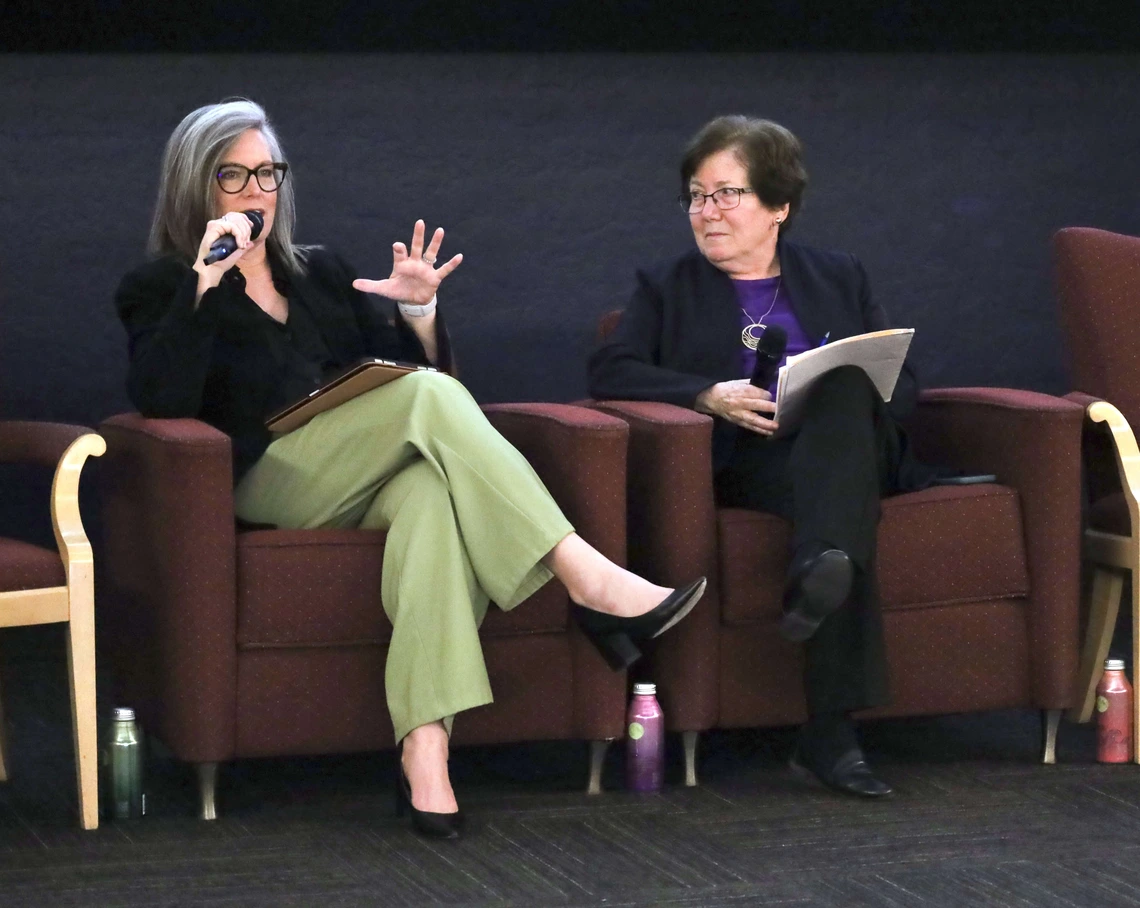Water Resources Research Center Conference Explores Partnerships on Every Level
The WRRC annual conference at University of Arizona pulled together hundreds of water stakeholders from around the world to discuss collaboration.

Arizona Governor Katie Hobbs and University of Arizona Water Resources Research Center Director Sharon Megdal answered questions from attendees.
Brad Poole, Cooperative Extension
Representatives from virtually every area of water research and management gathered this week at the University of Arizona’s Water Resources Research Center annual conference to explore how collaboration can help solve water problems on many levels.
The conference, which featured more than 50 panelists and speakers, brought together people from academia, government, environment groups and business to discuss and seek partnerships in water research and management. More than 700 people registered, either in person or via Zoom.
These gatherings and associated partnerships are vital to solving water problems, which transcend disciplines, sectors of society, and even generations, said Sharon Megdal director of the WRRC and a professor in the Department of Environmental Science.
“Dialogue is really important, and developing a common understanding of the problems and solutions is important, and networking is important,” Megdal said. “These are things that take continuing efforts of broadly diverse groups over time.”
The WRRC, which is part of the university’s Cooperative Extension System, serves an important role in connecting the academic world to the non-academic, and the annual conference is a part of that, she said.
Everything the university does is achieved through collaboration, said Shane Burgess, Vice President for the Division of Agriculture, Life and Veterinary Sciences, and Cooperative Extension.
“And I think that it’s pretty clear that water is the most critical issue of our time in Arizona and the Southwest,” Burgess said, calling Megdal a great example of collaboration.
Megdal serves on Gov. Katie Hobbs’ Water Policy Council, tasked with modernizing the 1980 Groundwater Management Act, which guides water use in the state’s five Active Management Areas, and she serves or has served on numerous other boards and commissions that inform and connect policymakers and researchers worldwide.
Hobbs, who gave a keynote address at the event, said the conference title theme, Implementing Water Solutions Through Partnerships, is timely. This past week the federal government finalized an interim water conservation deal among Colorado River basin states.
“Through the power of collaboration, we got a deal that protects Arizona from draconian cuts and ensures that no Arizonan will be forced to cut their water use. This collaboration has brought stability and given us time to negotiate a long-term solution for the Colorado River,” Hobbs said.
“Arizona has a long history of leading the way on water management, and we will continue to do so,” she said.
Gov. Stephen Roe Lewis of the Gila River Indian Community also spoke at the event and underscored the importance of tribal partnerships. Their most recent five-year plan, which is still in development, features continued reliance on collaboration and relationships across the state and nationally, Lewis said.
“We will need our allies to stand with us in the coming difficult months and years,” he said.
The conference was dedicated to the memory of Thomas Meixner, a renowned biochemistry researcher and head of the UA Department of Hydrology and Atmospheric Science who was shot and killed on campus in 2022.
A team of researchers working on a Thomas Meixner legacy tri-university project among UArizona, Arizona State University, and Northern Arizona University also presented at the event.
“The objectives of this project are to identify where and how water is currently evaporating and where it can be captured and recharged,” said Kathy Jacobs, director of the university’s Center for Climate Adaptation Science and Solutions and professor in the Department of Environmental Science.
The multidisciplinary team is using on-the-ground measurements and computer models to seek ways to save water that is figuratively falling through the cracks in urban and natural environments. By mapping where and how much water we are losing, the researchers hope to find ways to capture it and recharge aquifers.
Linneth Lopez and Rhona Mallea of the Arizona Department of Environmental Quality offered an overview of the department’s Advanced Water Purification program, which is building a roadmap to help communities use treated wastewater as a source for human consumption.
When the 1980 Groundwater Management Act limited groundwater use, interest in treated wastewater rose. This sparked a decades-long evolution of water reuse policies for local governments across Arizona, though currently no cities are delivering treated wastewater to homes.
Now ADEQ is working with other stakeholders to develop an advanced water purification “roadmap” to work toward household use of treated wastewater. The project will address risk management, treatment, monitoring, outreach and permitting.
Other partnerships highlighted at the conference include work to close gaps in research among water utilities and universities, UA President Robbins’ advisory Commission on the Future of Agriculture and Food Production in a Drying Climate, and interdisciplinary efforts to further alter flows on the Salt and Verde rivers to capture more water behind dams.

